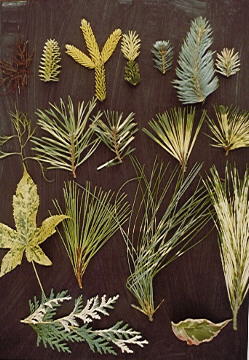Fastigiate Conifer Growth
Pinus strobus 'Stowe Pillar' (left) Pinus nigra 'Frank' (right)
A fastigiated conifer shows a central leaderís strong apical dominance that results in a straight trunk along its complete length. There also exists a lesser amount of apical dominance in the side branches, which also grow vertically upward. The branchlets are commonly repressed and usually just exhibit reduced, horizontal growth.
Apical dominance occurs in conifers and is exemplified by the suppression of lateral buds by the growing terminal bud. It affects the awakening of the lateral buds. It has no natural effect upon the buds that have overwintered on the tree. Apical control is the process by which the growing terminal shoot suppresses the growth of the lateral shoots that have erupted from the winter buds. It is a little-understood process but is believed to result from interactions between auxin, cytokinin, and environmental factors such as nutrients and water.
Auxin (indoleacetic acid) is produced in a rapidly growing young shoot tip. It promotes cell elongation at low concentrations. At higher concentrations, it can damage cells. It is quickly moved away from the end and down the stem, preventing lateral buds from growing (dominance) and growing branches from elongating to any great extent (control). How it works to do this is not entirely understood. One idea says that the flow downward blocks auxinís flow from a growing side branch, having an adverse effect upon cell elongation and stunting the branch. It may also help deflect nutrients away from the branch and force them to move up to the terminal shoot.
Cytokinin is produced in plant roots. It can also be made at a bud internode under certain conditions. It is transported up into the tree through the xylem as water moves upward. It promotes cell divisions and lateral bud development. I believe it plays a significant role in the formation of witchesí brooms. It is typically in a balance with auxin to regulate later buds and branchesí growth. If the terminal bud/shoot is removed and auxin flow is interrupted, the cytokinin will stimulate lateral bud growth. Additional cytokinin is produced at the bud when the auxin flow stops. Cytokinin interacts with the auxin being made in the side branches to stimulate growth while also causing them to turn upward when removed.
There is a genetic imbalance created between these chemicals when a fastigiated conifer develops. The prominent leader still demonstrates apical domination. However, each of the main side branches also shows apical control, but to a lesser degree. They grow vertically, meaning the same process is at work. I believe the difference is most likely related to nutrient and auxin flows. The side shoots grow slower due to a reduced flow of nutrients into them while auxin flows away.
Normally, side shoots start upward and become horizontal as time passes. Geotropism may be the process at work. Auxin responds to gravity and will concentrate on the lower side of a branch where the high concentration reduces cell elongation. Then lignin forms to lock the branch into place.
That process does not work in a fastigiated conifer. The terminals on the branches never become horizontal. The flow of auxin from the shoot must not be blocked so there is no harmful buildup on one side. The vertical growth continues and may only be interrupted if too much weight gathers at the branchesí ends.
| Home Page |
 |
| Conifer Bibliography | |
| Propagation Bibliography | |
| DVD | |
| Product List | |
| Our Story | |
| Plant Site Links |